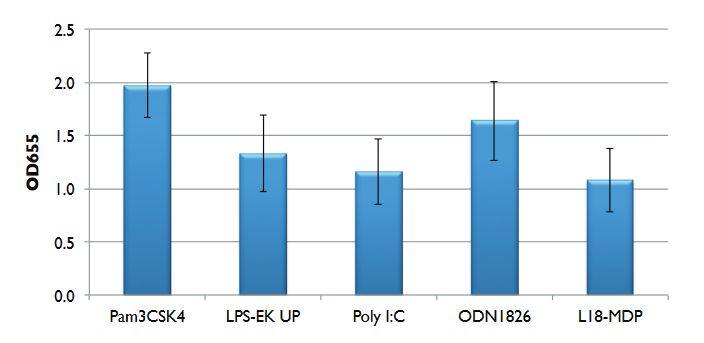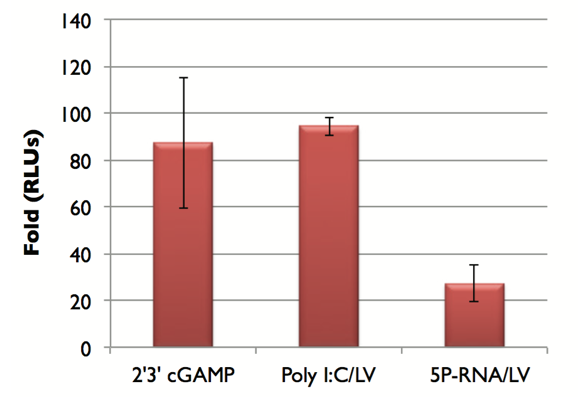J774-Dual™ Cells
| Product | Unit size | Cat. code | Docs. | Qty. | Price | |
|---|---|---|---|---|---|---|
|
J774-Dual™ Cells Murine NF-kB & IRF Reporter macrophage-like cells |
Show product |
3-7 x 10e6 cells |
j774d-nfis
|
|
||
|
J774-Dual™ vial Additional cell vial |
Show product |
3-7 x 10e6 cells |
j774d-nfis-av
|
Notification:
Reference #j774d-nfis-av can only be ordered together with reference #j774d-nfis.
NF-kB-SEAP & IRF-Luc Reporter Macrophages
J774-Dual™ cells have been derived from the mouse J774.1 macrophage-like cell line by stable integration of two inducible reporter constructs.
J774-Dual™ cells express a secreted embryonic alkaline phosphatase (SEAP) reporter gene under the control of an IFN-β minimal promoter fused to five copies of the NF-κB consensus transcriptional response element and three copies of the c-Rel binding site.
J774-Dual™ cells also express the Lucia luciferase gene, which encodes a secreted luciferase, under the control of an ISG54 minimal promoter in conjunction with five IFN-stimulated response elements.
As a result, J774-Dual™ cells allow to simultaneously study the NF-κB pathway, by assessing the activity of SEAP, and the interferon regulatory factor (IRF) pathway, by monitoring the activity of Lucia luciferase.
Both reporter proteins are readily measurable in the cell culture supernatant when using QUANTI-Blue™ Solution, a SEAP detection reagent, and QUANTI-Luc™ 4 Lucia/Gaussia, a Lucia and Gaussia luciferase detection reagent.
Specifications
Antibiotic resistance: Blasticidin and Zeocin®
Guaranteed mycoplasma-free
Quality Control:
- For each lot, proper activation of the NF-κB pathway and IRF pathway is confirmed upon stimulation of J774-Dual™ cells by various pathogen associated molecular patterns (PAMPs) known to activate these pathways.
- The stability of this cell line for 20 passages following thawing has been verified.
Contents
- 1 vial of J774-Dual™ cells (3-7 x 106 cells)
- 1ml of Blasticidin (10 mg/ml)
- 1 ml of Zeocin® (100 mg/ml)
- 1 ml of& Normocin™ (50 mg/ml)
- 1 tube of QUANTI-Luc™ 4 Reagent, a Lucia luciferase detection reagent (sufficient to prepare 25 ml)
- 1 ml of QB reagent and 1 ml of QB buffer (sufficient to prepare 100 ml of QUANTI-Blue™ Solution, a SEAP detection reagent)
![]() Shipped on dry ice (Europe, USA, Canada and some areas in Asia)
Shipped on dry ice (Europe, USA, Canada and some areas in Asia)
Details
J774.1 cells express a variety of pattern recognition receptors (PRRs), including Toll-like receptors (TLRs) [1, 2], C-type lectin receptors (CLRs) [2,3], RIG-I-like receptors (RLRs) [4].
Upon recognition of their cognate PAMPs, these receptors induce signaling pathways leading to the activation of the
transcription factors NF-kB and/or IRF3/7. Stimulation of J774-Dual™ cells with the following PAMPs, Pam3CSK4 (TLR1/2), lipopolisaccharide (TLR4), CpG ODNs (TLR9), L18-MDP (NOD2) and TDB (Mincle), leads to the activation of NF-kB.
Stimulation with RLR ligands, such as transfected poly(I:C) or 5’ppp-dsRNA, or the STING agonist, 2’3’-cGAMP, triggers the IRF pathway.
J774-Dual™ cells are resistant to the selectable markers blasticidin and Zeocin®.
1. Jin M. et al., 2011. Effects of chondroitin sulfate and its oligosaccharides on toll-like receptor-mediated IL-6 secretion by macrophage-like J774.1 cells. Biosci Biotechnol Biochem. 75(7):1283-9.
2. Kushida T. et al., 2011. Enhancement of Dectin-2 gene expression by lignin-carbohydrate complex from Lentinus edodes mycelia extract (LEM) in a mouse macrophage-like cell line. Anticancer Res. 31(4):1241-8.
3. Takeda Y. et al., 2007. Ternary complex consisting of DNA, polycation, and a natural polysaccharide of schizophyllan to induce cellular uptake by antigen presenting cells. Biomacromolecules. 8(4):1178-86.
4. Wilden H. et al., 2009. Expression of RIG-I, IRF3, IFN-beta and IRF7 determines resistance or susceptibility of cells to infection by Newcastle Disease Virus. Int J Oncol. 34(4):971-82.








